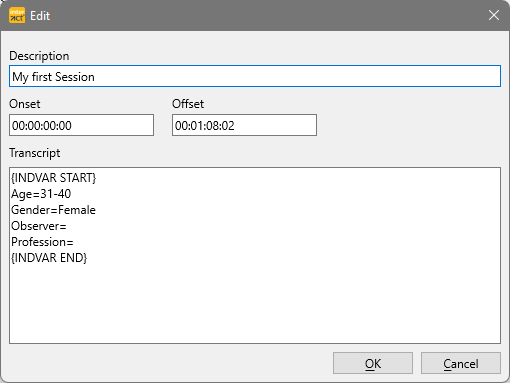As described in INTERACT essentials, INTERACT offers two hierarchical elements to structure your observations:
oDataGroup
oDataSet.
Typically, each situation or session is covered by a DataSet.
Once you have more than observation, identification of the data per DataSet becomes important. Especially BEFORE you merge multiple observations for analysis.
Proper identification provides easier-to-read statistics and simplifies data selection during analysis.
Note: Before you restructure your file(s) or merge data files, make sure you can identify the content of each DataSet WITHOUT the original file name.
The simplest method of identification, is descriptive information in the Description line:
▪Select the Set line you want to edit.
▪Click into the Decription area and start typing.
Or
▪Right-click in description field of the Set or Group line you want to edit:
▪Choose Edit to open the Description dialog:

▪Enter the description that identifies the session within.
▪Click OK to confirm your entry.
IMPORTANT: Enter this information before merging multiple data files!
Make sure the data can be identified without the original filename.
| TIP: | The routine > Copy descriptions from DataGroups to associated DataSets can be found under Insert - Advanced - Add |
For larger studies, with many DataSets per document, identification through the description line alone becomes insufficient.
Especially if you need to select specific DataSets during Analysis in various combinations (e.g. all males versus all females or split by age, nationality or any of the other characteristics per participant):
oYou can define as many Metadata-variables as you need.
oYou need to assign the appropriate Metadata values for each Metadata-variable per DataSet.
oIt is possible to predefine value lists to choose from, as described in Define Metadata- Variables.
oMetadata-Variables and their values are listed in the Statistics per Code results.
oYou can limit your selection with the help of Metadata-variables for all DataSet-based statistics as well as all Class-based statistics.
oIt is also possible to make a raw data selection, based on the available Metadata.
Note: All Metadata is also available for export, both for exporting results and when exporting raw data, thus you can work with this information in third party applications like 'R', MS Excel, or SPSS as well.
